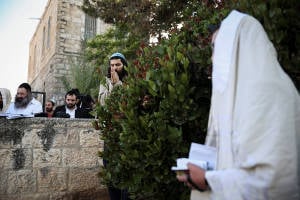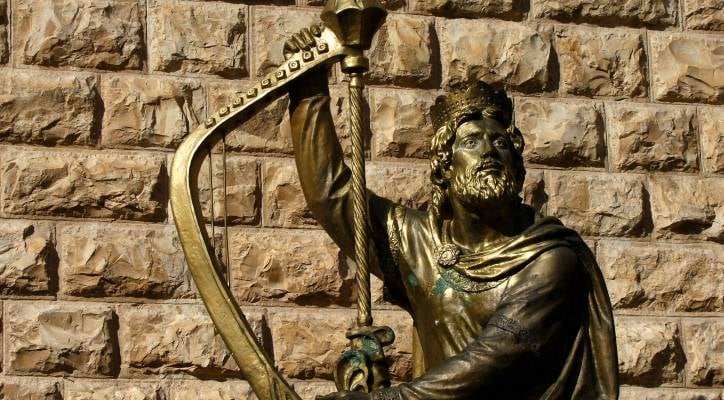Whether the summit of Mount Zion is the actual burial place of King David or was used for his descendants, the area nevertheless became sanctified.
At the peak of Mt. Zion stands a magnificent old house known to all as the “Tomb of King David.” About 3000 years ago, King David was the first leader to successfully unite all of the twelve tribes of Israel. When David became king, his capital was in the city of Hebron, which is located in the tribal territory of Judah.
In his desire to unite the 12 tribes of Israel, David realized that he must relocate the capital to a neutral location not controlled by any one tribe. By doing so, each tribe would feel that they have a portion in the capital, similar to Washington, DC, which is not located in any particular state. So David, at the age of 37, conquered a small hill called Jebus and it became known as the City of David.
On the Pentecost (Shavuot), the place is filled to capacity because in Jewish tradition this is the holiday on which King David was born and died. The crowd lights candles and recites the Psalms that, according to tradition, were written mostly by King David.
But is King David really buried there on top of Mount Zion, or perhaps he is buried just below in the City of David hill, as stated in I Kings (Chapter 2, verse 10): “And David slept with his fathers and was buried in the city of David”? To answer this question we cannot rely on the Bible alone, since no one knows if all of Jerusalem was called the City of David in ancient times.
The oldest written sources on this subject take us back a thousand years to the Middle Ages. At the time, Jews, Muslims and Christians visited Jerusalem and described in their writings their exciting visits to Mount Zion, where they saw not only the Tomb of King David, but also the tombs of all the Kings of Judah. So based on this, one could say that King David is in fact buried here on Mount Zion.

Praying outside King David’s Tomb (Hadas Parush/Flash90)
Archaeology also has something to say about it: Excavations of Mount Zion conducted 30 years ago by Prof. Gabi Barkay of the Hebrew University reveal magnificent burial caves dating back to the days of the kings of the House of David. The cave is about 50 meters north from the grave today (Unfortunately you cannot visit it today). Professor Barkai did not find any inscription indicating the identity of the deceased, but he thinks that it may have served King David himself, and if not, then perhaps his descendants. He suggests that the place can be identified as “Gan Uza,” which was used for the burial of the Davidic dynasty from the time of King Manasseh, as described in the Book of Kings II(21:18): “And Manasseh slept with his fathers and was buried at Gan Uza.”
For those who do not believe that the tomb on Mount Zion identified as David’s Tomb is authentic, there is an alternative. In 1913, French archaeologist-Egyptologist Raymond Weill went searching for the tomb in the City of David. Weil discovered eight man-made, cave-like structures that he identified as tombs. In another expedition in 1923-4 he discovered a ninth cave. Weill declared that he had discovered the tomb of King David and the Davidic dynasty. Initially, Weill’s discovery was generally accepted, but today there are many who disagree with him.
Whether the summit of Mount Zion is the actual burial place of King David or was used for his descendants, the place nevertheless became sanctified and is an important pilgrimage center in Jerusalem. Definitely worth a visit!
By: Rabbi Moshe Rothchild, United with Israel
